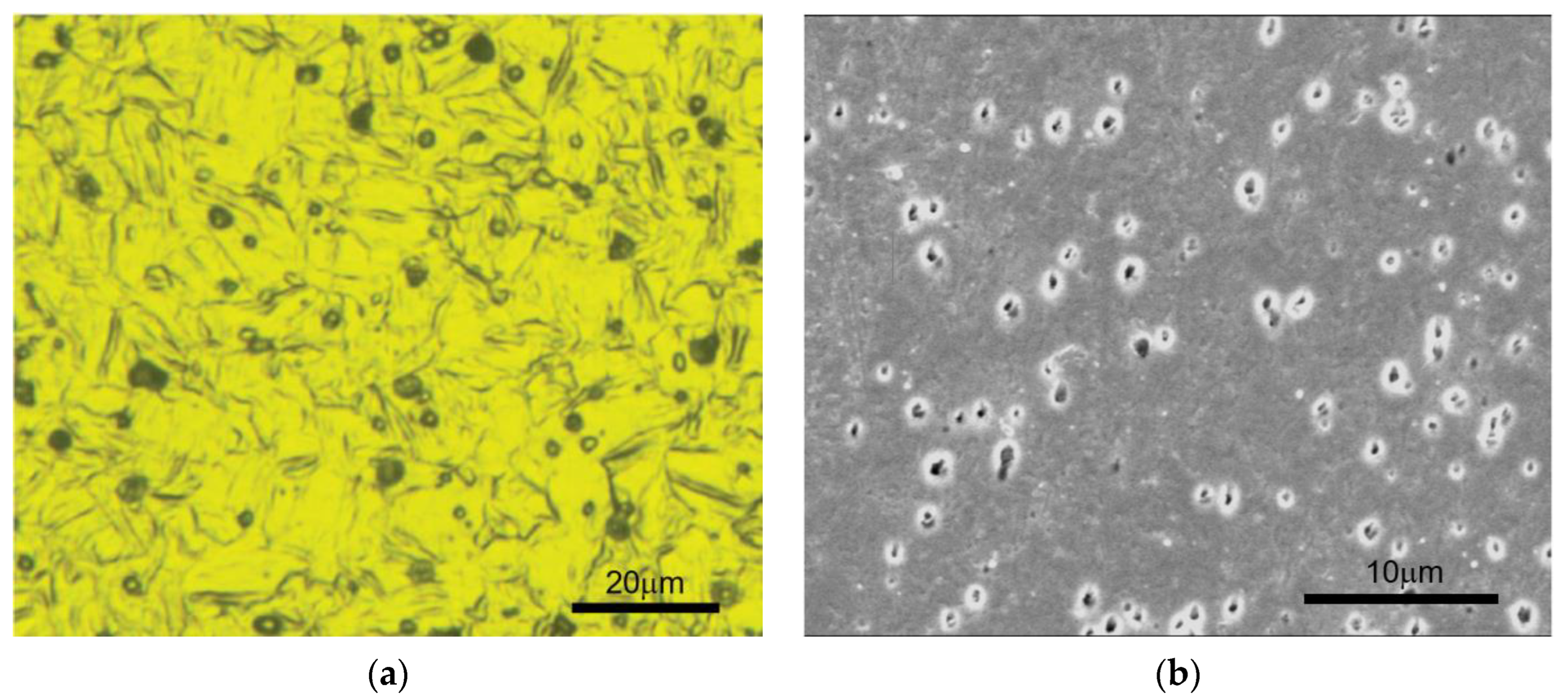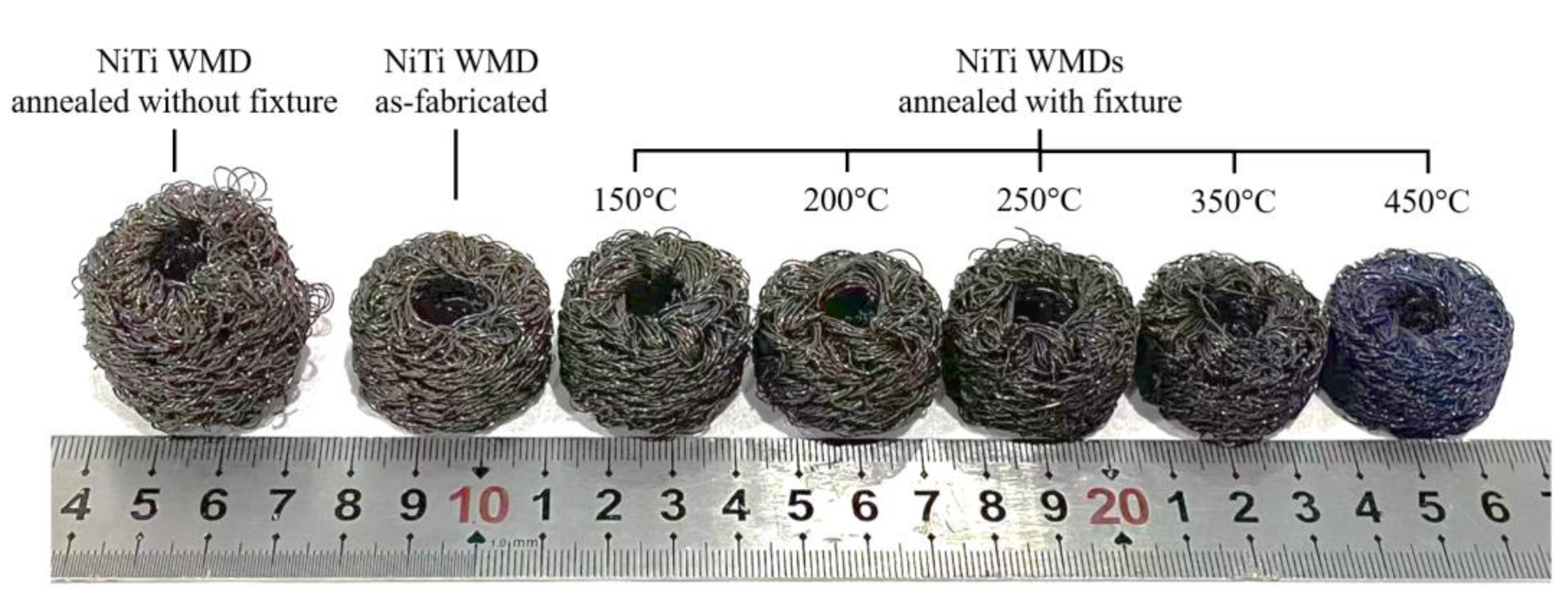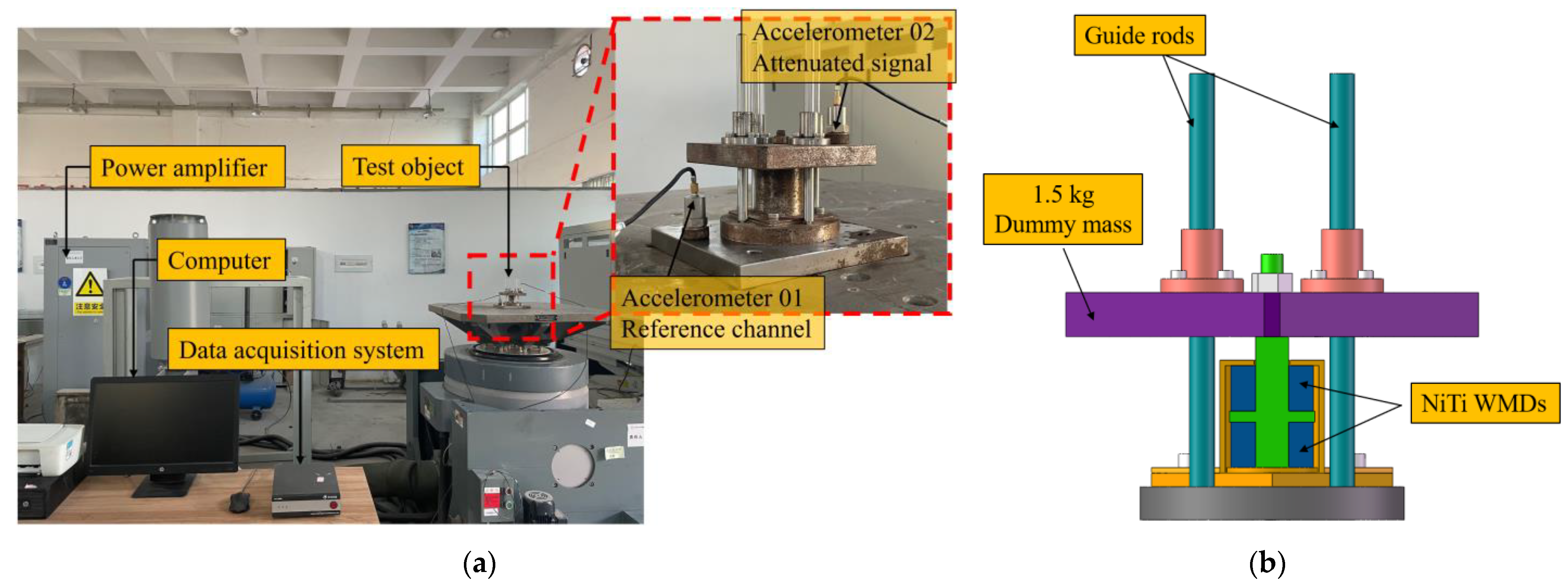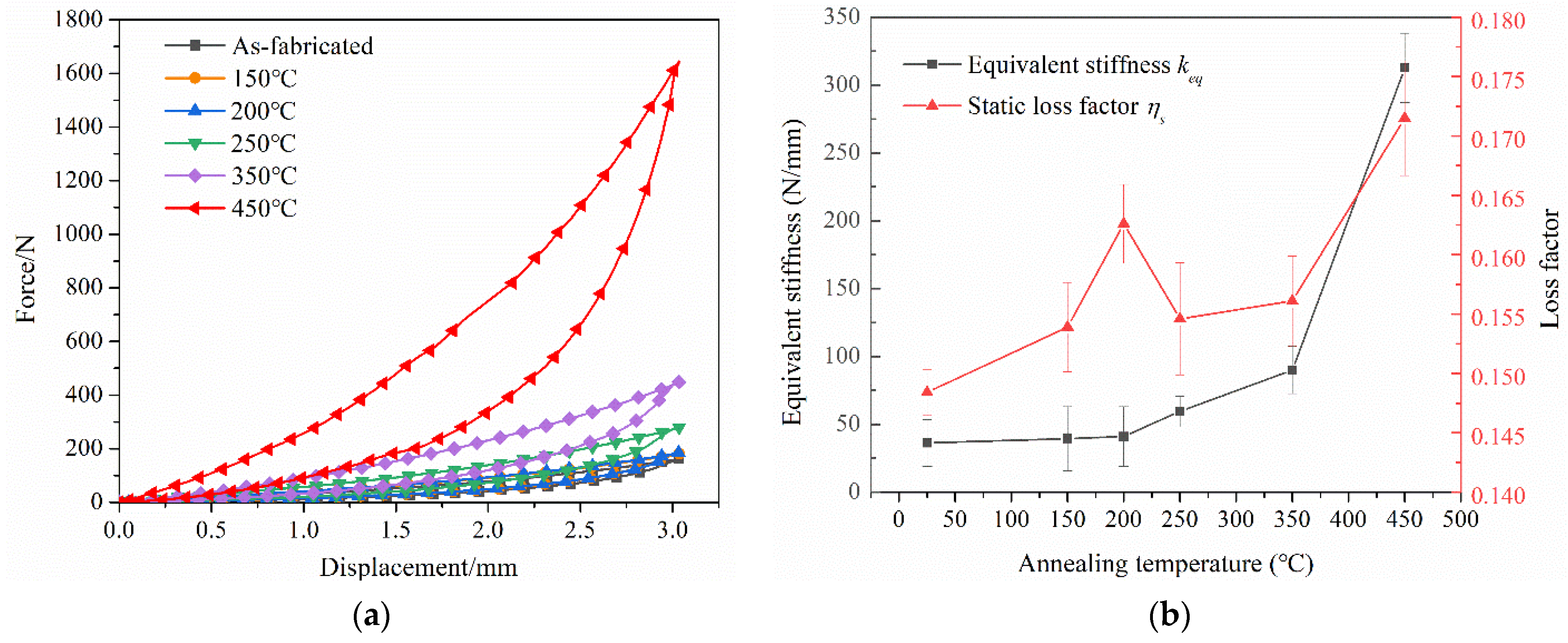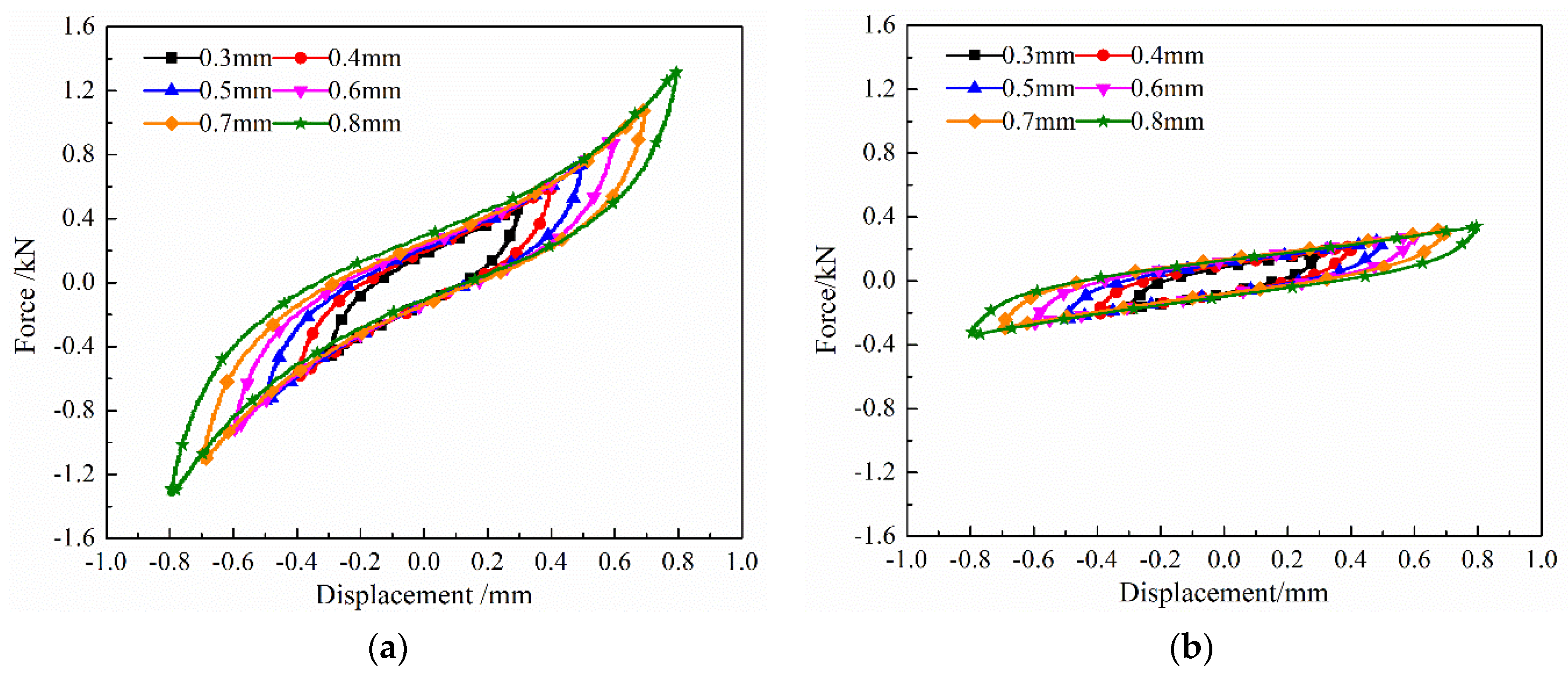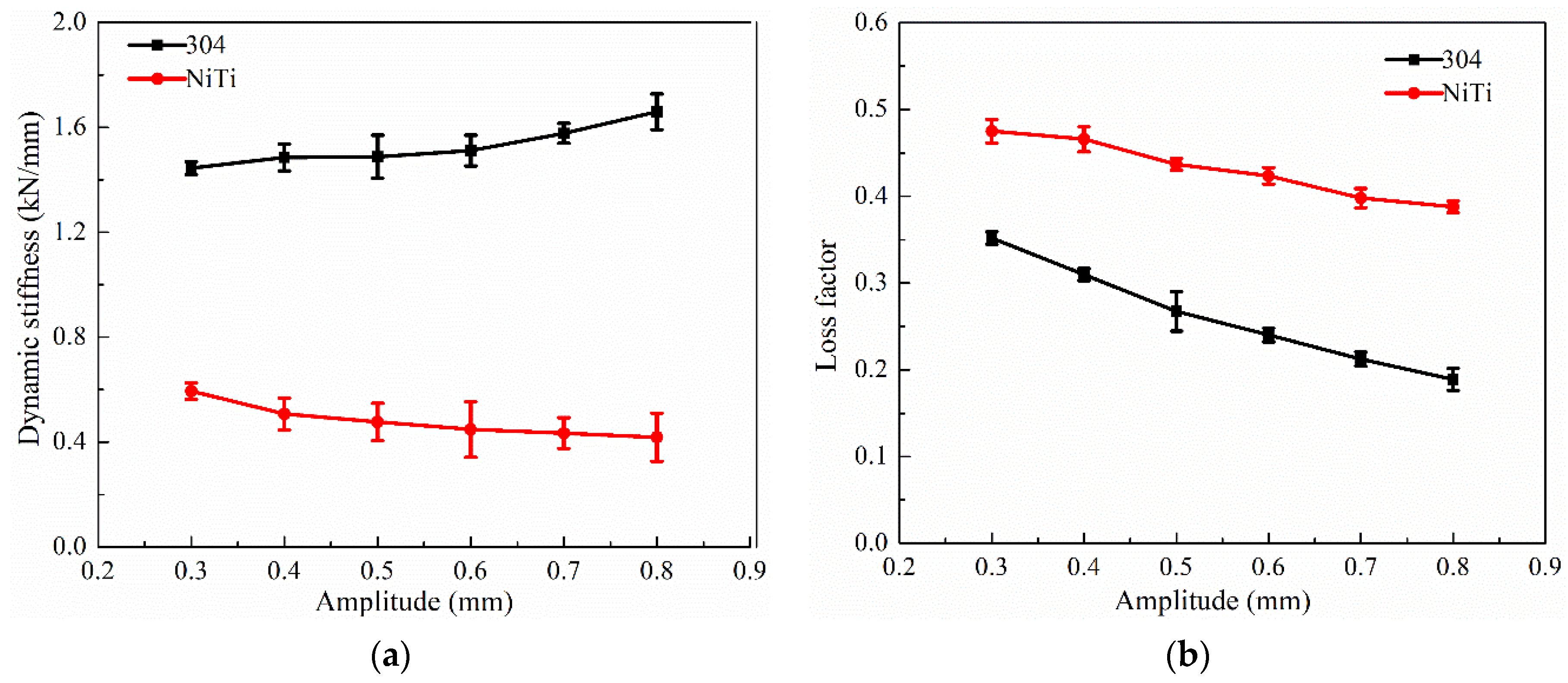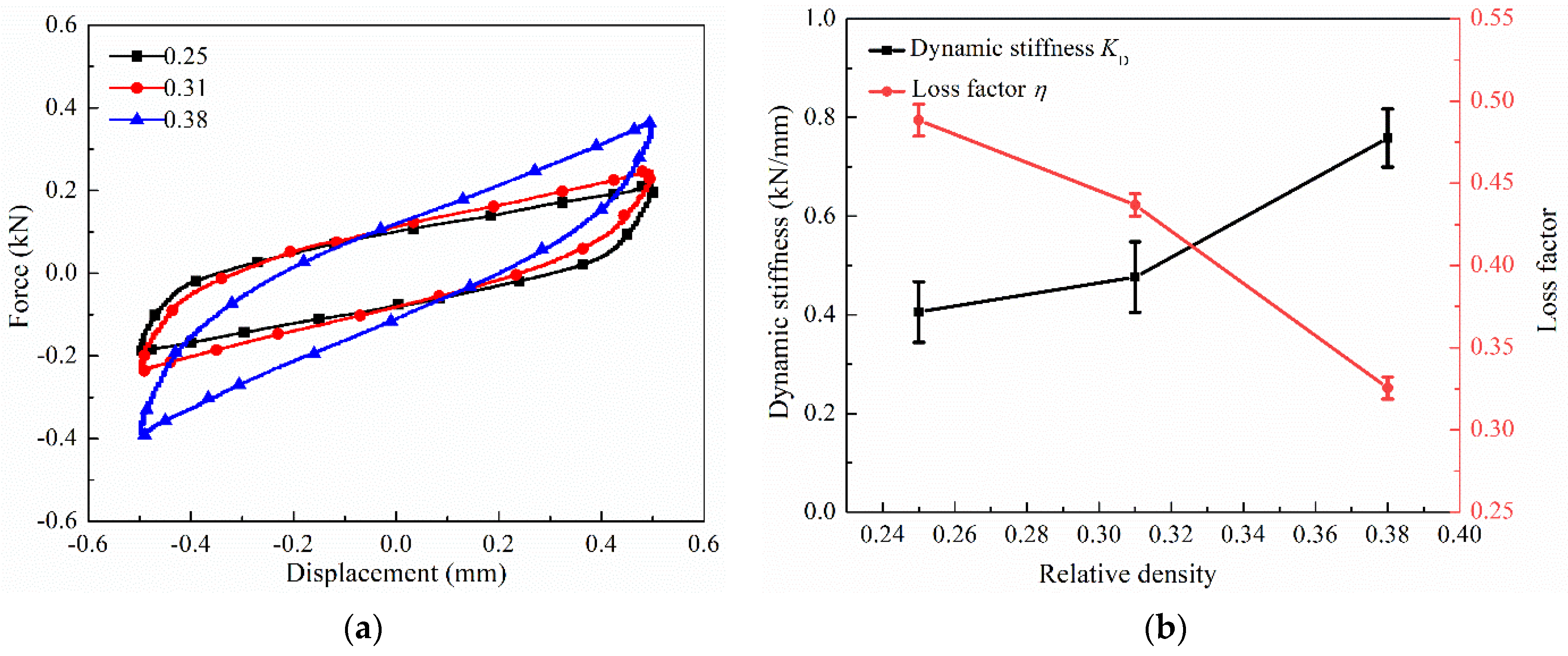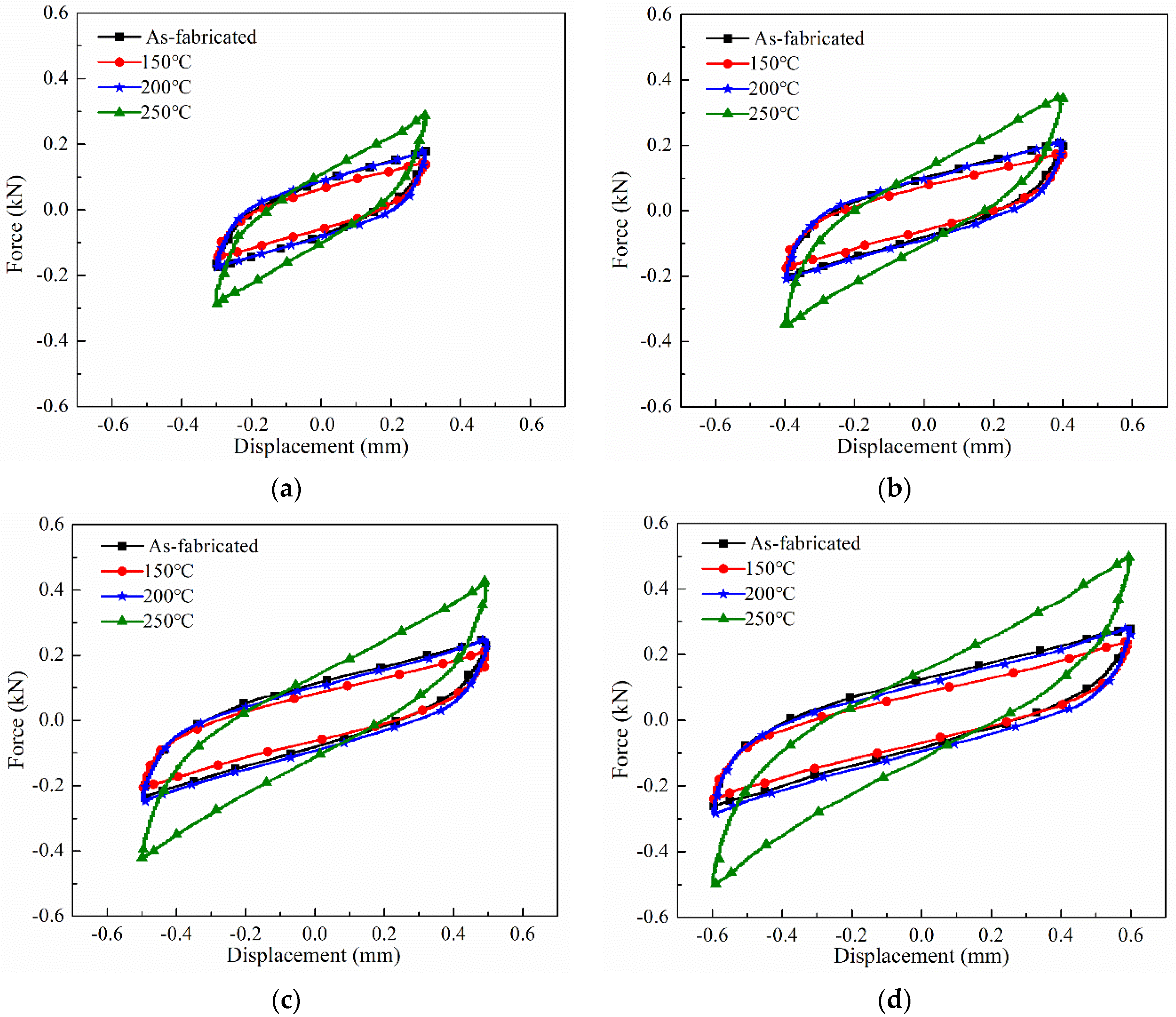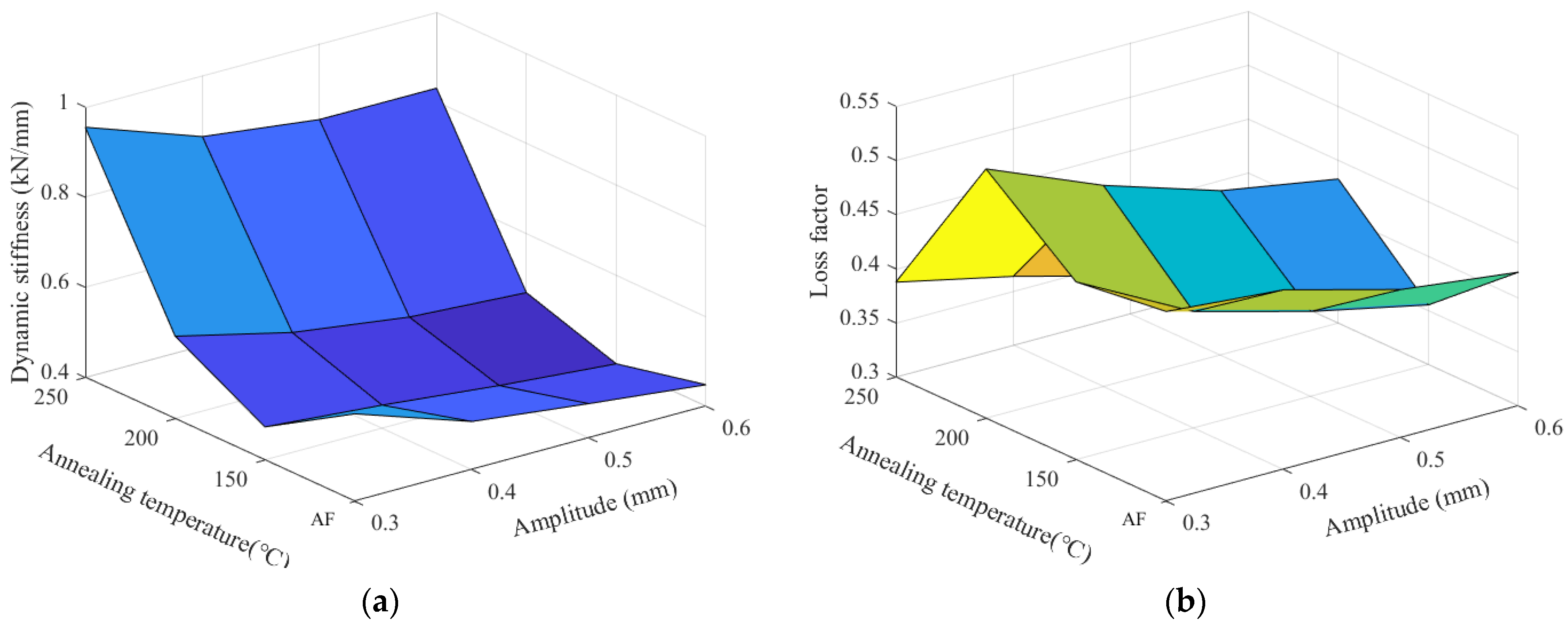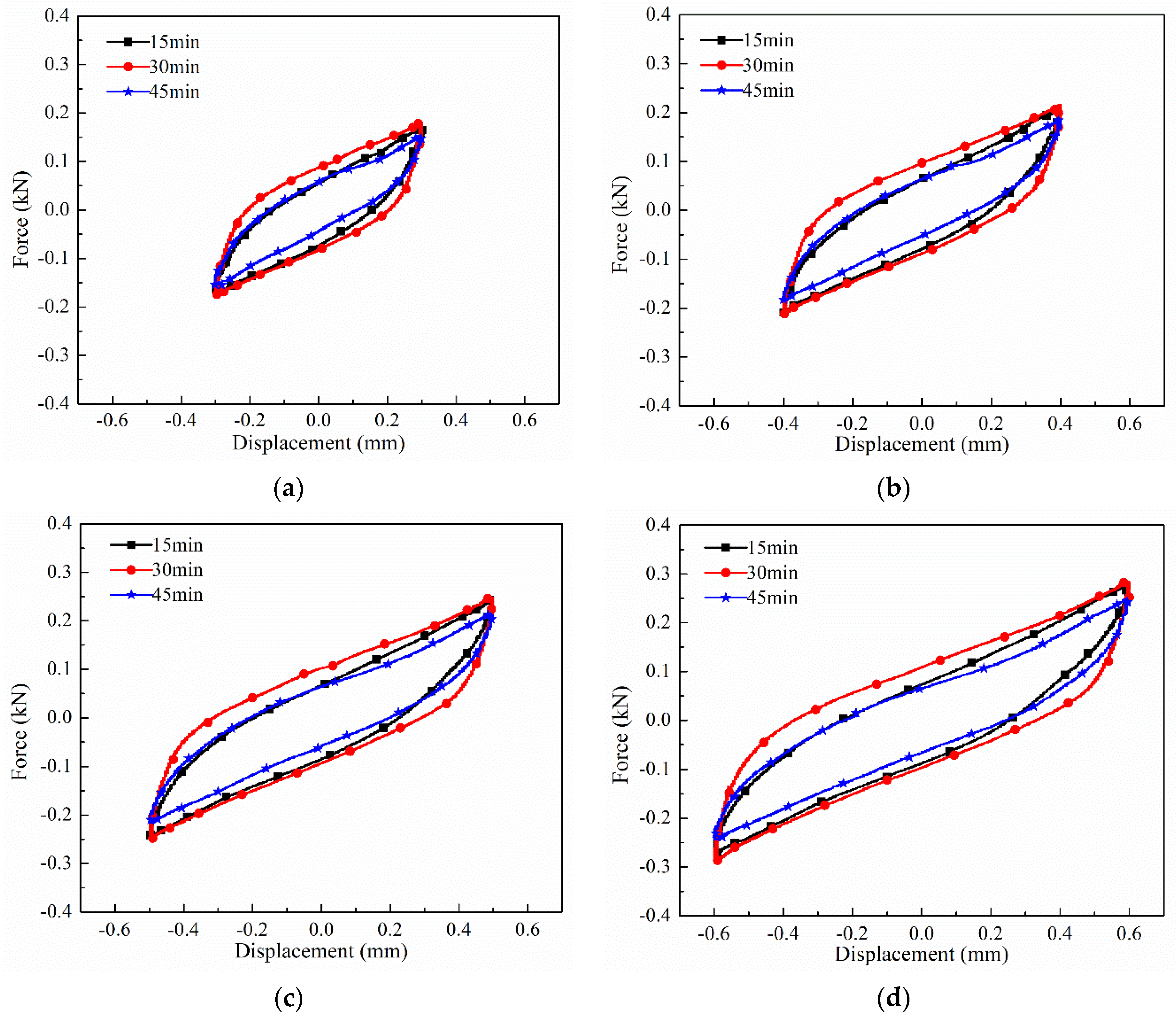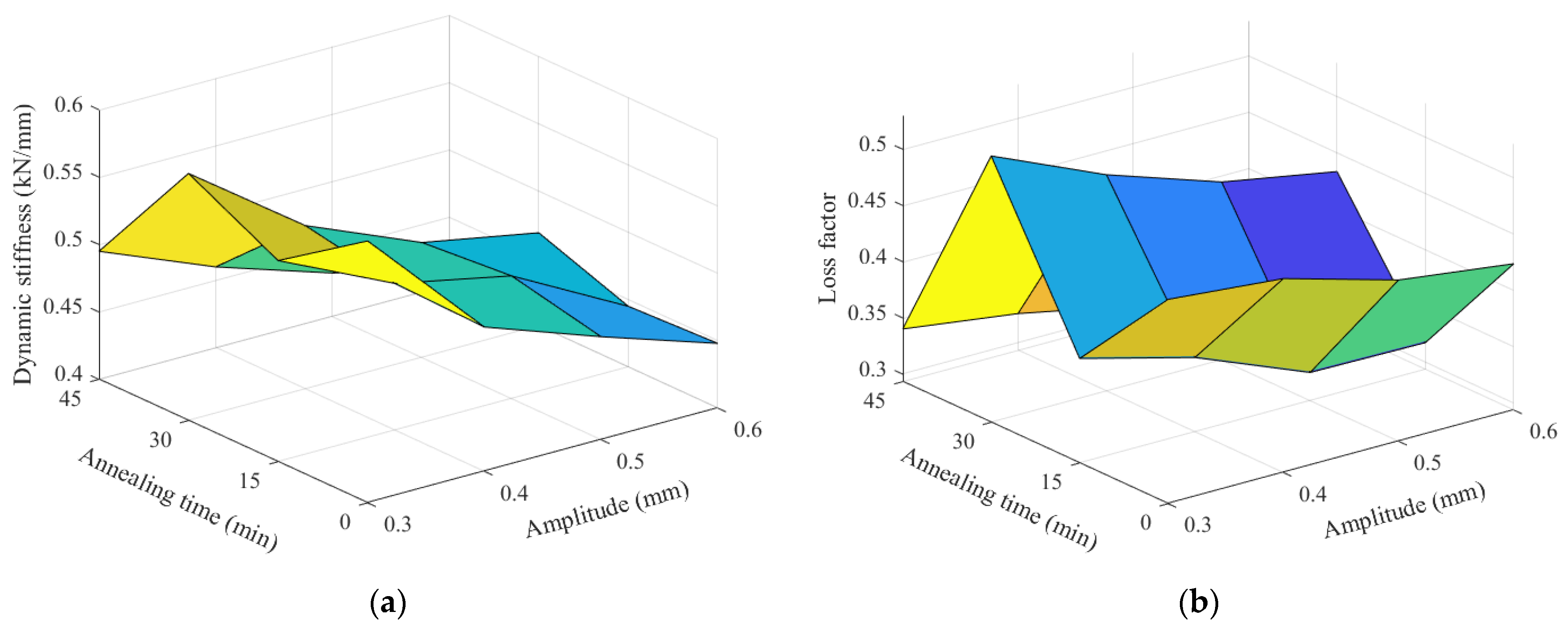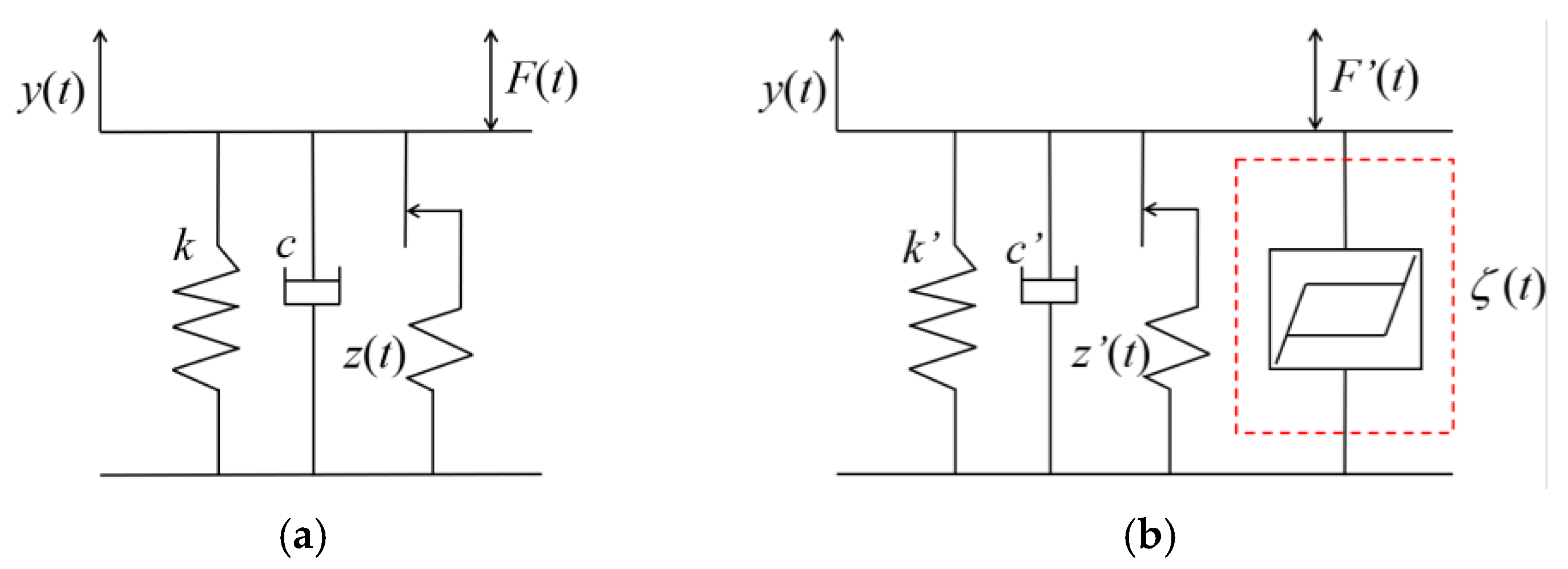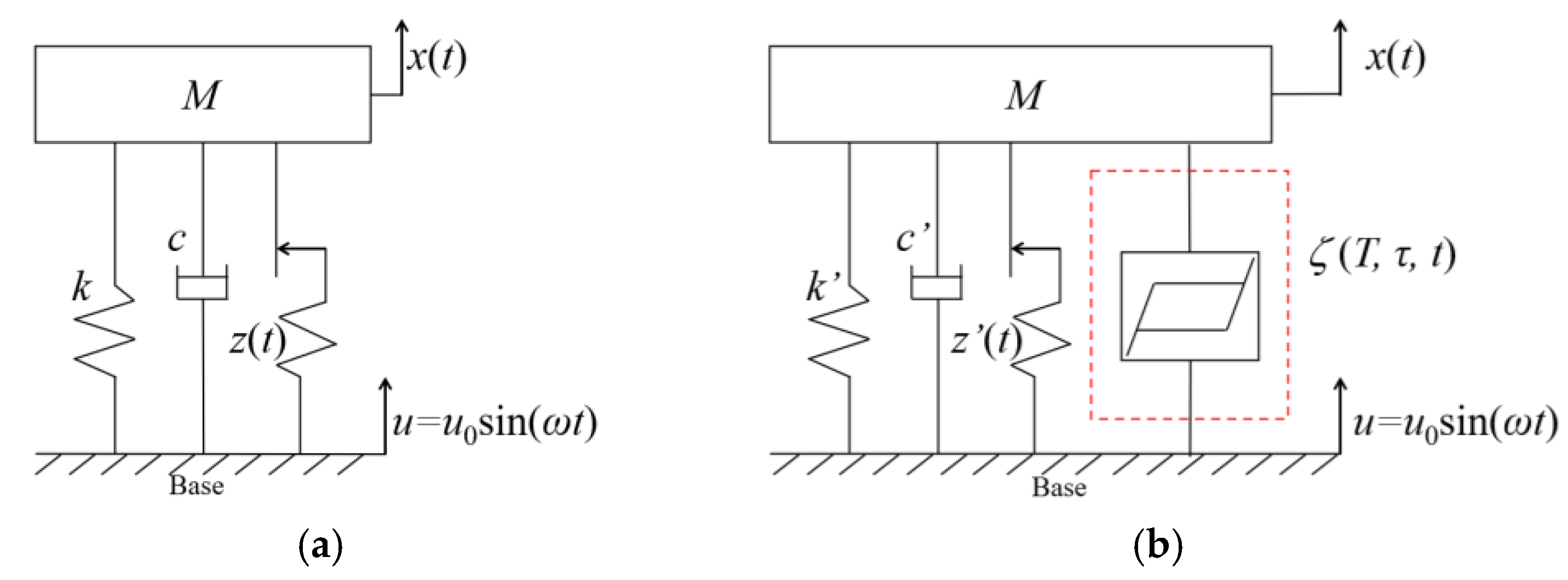Figure 1.
Optical micrographs of the as-received wire materials. (a) SE NiTi wire; (b) SS 304 wire.
Figure 1.
Optical micrographs of the as-received wire materials. (a) SE NiTi wire; (b) SS 304 wire.
Figure 2.
Fabrication procedure of SE NiTi WMDs.
Figure 2.
Fabrication procedure of SE NiTi WMDs.
Figure 3.
Fixtures used to restrain the NiTi WMD for maintaining its geometry during heat treatment.
Figure 3.
Fixtures used to restrain the NiTi WMD for maintaining its geometry during heat treatment.
Figure 4.
A comparison between the NiTi WMD heat-treated without fixtures and those heat-treated with fixtures.
Figure 4.
A comparison between the NiTi WMD heat-treated without fixtures and those heat-treated with fixtures.
Figure 5.
SDS-200 dynamic testing machine and the setup details of the NiTi WMDs.
Figure 5.
SDS-200 dynamic testing machine and the setup details of the NiTi WMDs.
Figure 6.
Configuration of the sine sweep test. (a) The key components of the test system and the location of the accelerometers; (b) the sectional view of the WMD isolator.
Figure 6.
Configuration of the sine sweep test. (a) The key components of the test system and the location of the accelerometers; (b) the sectional view of the WMD isolator.
Figure 7.
The acceleration profile of the sine sweep test.
Figure 7.
The acceleration profile of the sine sweep test.
Figure 8.
Effect of heat treatment temperature on the pseudo-static mechanical performance of NiTi WMDs. (a) hysteresis curves; (b) equivalent stiffness and loss factor.
Figure 8.
Effect of heat treatment temperature on the pseudo-static mechanical performance of NiTi WMDs. (a) hysteresis curves; (b) equivalent stiffness and loss factor.
Figure 9.
Comparison of dynamic curves of WMDs fabricated with different materials: (a) SS 304; (b) SE NiTi.
Figure 9.
Comparison of dynamic curves of WMDs fabricated with different materials: (a) SS 304; (b) SE NiTi.
Figure 10.
Variation of WMD’s dynamic stiffness and loss factor with amplitude. (a) Dynamic stiffness; (b) loss factor.
Figure 10.
Variation of WMD’s dynamic stiffness and loss factor with amplitude. (a) Dynamic stiffness; (b) loss factor.
Figure 11.
Dynamic performance of NiTi WMDs with different densities. (a) Hysteresis curves of force versus displacement; (b) characterized dynamic stiffness and loss factor evolving with mesh density.
Figure 11.
Dynamic performance of NiTi WMDs with different densities. (a) Hysteresis curves of force versus displacement; (b) characterized dynamic stiffness and loss factor evolving with mesh density.
Figure 12.
Effect of heat treatment temperature on the dynamic hysteresis behavior of NiTi WMDs with displacement amplitudes of: (a) 0.3 mm; (b) 0.4 mm; (c) 0.5 mm; (d) 0.6 mm.
Figure 12.
Effect of heat treatment temperature on the dynamic hysteresis behavior of NiTi WMDs with displacement amplitudes of: (a) 0.3 mm; (b) 0.4 mm; (c) 0.5 mm; (d) 0.6 mm.
Figure 13.
Characterization of the dynamic hysteresis behavior of NiTi WMDs heat-treated at different temperatures: (a) dynamic stiffness; (b) loss factor.
Figure 13.
Characterization of the dynamic hysteresis behavior of NiTi WMDs heat-treated at different temperatures: (a) dynamic stiffness; (b) loss factor.
Figure 14.
Effect of heat treatment time on the NiTi WMD’s dynamic hysteresis behavior with various displacement amplitudes: (a) 0.3 mm; (b) 0.4 mm; (c) 0.5 mm; (d) 0.6 mm.
Figure 14.
Effect of heat treatment time on the NiTi WMD’s dynamic hysteresis behavior with various displacement amplitudes: (a) 0.3 mm; (b) 0.4 mm; (c) 0.5 mm; (d) 0.6 mm.
Figure 15.
Characterization of the dynamic hysteresis behavior of NiTi WMDs heat-treated for different times: (a) dynamic stiffness; (b) loss factor.
Figure 15.
Characterization of the dynamic hysteresis behavior of NiTi WMDs heat-treated for different times: (a) dynamic stiffness; (b) loss factor.
Figure 16.
Comparison of the vibration isolation performance of WMDs fabricated with different materials: (a) SS 304; (b) SE NiTi.
Figure 16.
Comparison of the vibration isolation performance of WMDs fabricated with different materials: (a) SS 304; (b) SE NiTi.
Figure 17.
Characterization of the vibration isolation performance of WMDs. (a) Natural frequency; (b) Peak transmissibility; (c) Loss factor.
Figure 17.
Characterization of the vibration isolation performance of WMDs. (a) Natural frequency; (b) Peak transmissibility; (c) Loss factor.
Figure 18.
Effect of the mesh density on the acceleration transmissibility of the vibration-isolation system subjected to the 1 g sine sweep test.
Figure 18.
Effect of the mesh density on the acceleration transmissibility of the vibration-isolation system subjected to the 1 g sine sweep test.
Figure 19.
Characterization of vibration isolation performance of NiTi WMDs fabricated with different densities: (a) natural frequency; (b) peak transmissibility; (c) loss factor.
Figure 19.
Characterization of vibration isolation performance of NiTi WMDs fabricated with different densities: (a) natural frequency; (b) peak transmissibility; (c) loss factor.
Figure 20.
Effect of heat treatment temperature on the acceleration transmissibility of a vibration-isolation system subjected to the 1 g sine sweep test.
Figure 20.
Effect of heat treatment temperature on the acceleration transmissibility of a vibration-isolation system subjected to the 1 g sine sweep test.
Figure 21.
Characterization of vibration isolation performance of NiTi WMDs heat-treated at different temperatures. (a) Natural frequency; (b) peak transmissibility; (c) loss factor.
Figure 21.
Characterization of vibration isolation performance of NiTi WMDs heat-treated at different temperatures. (a) Natural frequency; (b) peak transmissibility; (c) loss factor.
Figure 22.
Effect of heat treatment time on the acceleration transmissibility of a vibration-isolation system subjected to the 1 g sine sweep test.
Figure 22.
Effect of heat treatment time on the acceleration transmissibility of a vibration-isolation system subjected to the 1 g sine sweep test.
Figure 23.
Characterization of vibration isolation performance of NiTi WMDs heat-treated for different times. (a) Resonant frequency; (b) peak transmissibility; (c) loss factor.
Figure 23.
Characterization of vibration isolation performance of NiTi WMDs heat-treated for different times. (a) Resonant frequency; (b) peak transmissibility; (c) loss factor.
Figure 24.
First-order SDOF system of WMD isolator under dynamic load. (a) SS 304 WMD; (b) SE NiTi WMD.
Figure 24.
First-order SDOF system of WMD isolator under dynamic load. (a) SS 304 WMD; (b) SE NiTi WMD.
Figure 25.
Second-order SDOF system of WMD isolator under forced vibration. (a) SS 304 WMD; (b) SE NiTi WMD.
Figure 25.
Second-order SDOF system of WMD isolator under forced vibration. (a) SS 304 WMD; (b) SE NiTi WMD.
Table 1.
Chemical composition of the SE NiTi material (wt.%).
Table 1.
Chemical composition of the SE NiTi material (wt.%).
| Ni | C | O | N | H | Ti |
|---|
| 56.07 | 0.007 | 0.013 | 0.001 | 0.00007 | Balance |
Table 2.
Chemical composition of the SS 304 material (wt.%).
Table 2.
Chemical composition of the SS 304 material (wt.%).
| C | Cr | Mn | Si | P | S | Ni | Mo | Fe |
|---|
| 0.072 | 17.820 | 1.421 | 0.395 | 0.041 | 0.011 | 7.946 | 0.276 | Balance |
Table 3.
Basic fabrication parameters for SS 304 and SE NiTi WMDs.
Table 3.
Basic fabrication parameters for SS 304 and SE NiTi WMDs.
| No. | Wire Material | Wire
Mass (g) |
(g/cm3)
|
(g/cm3)
| | Forming Pressure (Tonne) |
|---|
| 1 | SS 304 | 22.25 | 7.9 | 2.5 | 0.31 | 3 |
| 2 | NiTi | 14.6 | 6.5 | 2.0 | 0.25 | 17 |
| 3 | NiTi | 18.25 | 6.5 | 2.5 | 0.31 | 23 |
| 4 | NiTi | 22 | 6.5 | 3.0 | 0.38 | 27 |
Table 4.
Test groups with various factors of material, relative density, heat treatment temperature, and heat treatment time.
Table 4.
Test groups with various factors of material, relative density, heat treatment temperature, and heat treatment time.
| No. | Material | Relative Density | Heat Treatment Temperature (°C) | Heat Treatment Time (min) |
|---|
| 1 | 304, NiTi | 0.31 | -- | -- |
| 2 | NiTi | 0.25, 0.31, 0.38 | -- | -- |
| 3 | NiTi | 0.31 | 150, 200, 250 | 30 |
| 4 | NiTi | 0.31 | 200 | 15, 30, 45 |
Table 5.
Dynamic performance parameters of WMDs fabricated with different materials.
Table 5.
Dynamic performance parameters of WMDs fabricated with different materials.
| Amplitude (mm) | Dynamic Stiffness KD (kN/mm) | Loss Factor η |
|---|
| 304 | NiTi | 304 | NiTi |
|---|
| 0.3 | 1.44 ± 0.02 | 0.59 ± 0.03 | 0.35 ± 0.01 | 0.48 ± 0.01 |
| 0.4 | 1.49 ± 0.05 | 0.51 ± 0.06 | 0.31 ± 0.01 | 0.47 ± 0.01 |
| 0.5 | 1.49 ± 0.08 | 0.48 ± 0.07 | 0.27 ± 0.02 | 0.44 ± 0.01 |
| 0.6 | 1.51 ± 0.06 | 0.45 ± 0.11 | 0.24 ± 0.01 | 0.42 ± 0.01 |
| 0.7 | 1.58 ± 0.04 | 0.43 ± 0.06 | 0.21 ± 0.01 | 0.40 ± 0.01 |
| 0.8 | 1.66 ± 0.07 | 0.42 ± 0.09 | 0.19 ± 0.01 | 0.39 ± 0.01 |
Table 6.
Dynamic performance parameters of NiTi WMD with different densities.
Table 6.
Dynamic performance parameters of NiTi WMD with different densities.
| | Relative Density |
|---|
| | 0.25 | 0.31 | 0.38 |
|---|
| Dynamic stiffness KD (kN/mm) | 0.41 ± 0.06 | 0.48 ± 0.07 | 0.76 ± 0.06 |
| Loss factor η | 0.49 ± 0.01 | 0.44 ± 0.01 | 0.33 ± 0.01 |
Table 7.
Dynamic stiffness parameters at different heat treatment temperatures.
Table 7.
Dynamic stiffness parameters at different heat treatment temperatures.
| Amplitude (mm) | Heat Treatment Temperature (°C) |
|---|
| 25 | 150 | 200 | 250 |
|---|
| 0.3 | 0.59 ± 0.03 | 0.47 ± 0.07 | 0.58 ± 0.05 | 0.96 ± 0.02 |
| 0.4 | 0.51 ± 0.06 | 0.45 ± 0.03 | 0.52 ± 0.04 | 0.86 ± 0.01 |
| 0.5 | 0.48 ± 0.07 | 0.42 ± 0.08 | 0.49 ± 0.07 | 0.83 ± 0.03 |
| 0.6 | 0.45 ± 0.11 | 0.40 ± 0.01 | 0.47 ± 0.02 | 0.83 ± 0.04 |
Table 8.
Loss factor parameters at different heat treatment temperatures.
Table 8.
Loss factor parameters at different heat treatment temperatures.
| Amplitude (mm) | Heat Treatment Temperature (°C) |
|---|
| 25 | 150 | 200 | 250 |
|---|
| 0.3 | 0.48 ± 0.01 | 0.46 ± 0.03 | 0.53 ± 0.04 | 0.39 ± 0.06 |
| 0.4 | 0.47 ± 0.01 | 0.41 ± 0.01 | 0.49 ± 0.05 | 0.36 ± 0.03 |
| 0.5 | 0.44 ± 0.01 | 0.38 ± 0.04 | 0.45 ± 0.01 | 0.33 ± 0.02 |
| 0.6 | 0.42 ± 0.01 | 0.36 ± 0.01 | 0.43 ± 0.02 | 0.31 ± 0.01 |
Table 9.
Dynamic stiffness parameters at different heat treatment times.
Table 9.
Dynamic stiffness parameters at different heat treatment times.
| Amplitude (mm) | Heat Treatment Time (min) |
|---|
| 15 | 30 | 45 |
|---|
| 0.3 | 0.55 ± 0.06 | 0.58 ± 0.05 | 0.50 ± 0.03 |
| 0.4 | 0.51 ± 0.03 | 0.52 ± 0.04 | 0.46 ± 0.01 |
| 0.5 | 0.49 ± 0.01 | 0.49 ± 0.07 | 0.43 ± 0.04 |
| 0.6 | 0.45 ± 0.04 | 0.47 ± 0.02 | 0.41 ± 0.01 |
Table 10.
Loss factor parameters at different heat treatment times.
Table 10.
Loss factor parameters at different heat treatment times.
| Amplitude (mm) | Heat Treatment Time (min) |
|---|
| 15 | 30 | 45 |
|---|
| 0.3 | 0.39 ± 0.04 | 0.53 ± 0.04 | 0.34 ± 0.05 |
| 0.4 | 0.36 ± 0.01 | 0.49 ± 0.05 | 0.33 ± 0.05 |
| 0.5 | 0.32 ± 0.02 | 0.45 ± 0.01 | 0.31 ± 0.03 |
| 0.6 | 0.32 ± 0.01 | 0.43 ± 0.02 | 0.29 ± 0.03 |
Table 11.
Sinusoidal sweep test parameters of metal rubber shock absorbers of different materials.
Table 11.
Sinusoidal sweep test parameters of metal rubber shock absorbers of different materials.
| | | Vibration Magnitude (g) |
|---|
| | | 0.25 | 0.5 | 1.0 | 1.5 | 2.0 |
|---|
| 304 | Natural frequency (Hz) | 121.8 ± 6.7 | 92.2 ± 5.4 | 65.0 ± 3.7 | 49.4 ± 4.2 | 41.8 ± 6.6 |
| Peak transmissibility | 3.37 ± 0.13 | 2.85 ± 0.16 | 2.34 ± 0.08 | 2.34 ± 0.14 | 3.01 ± 0.16 |
| Loss factor | 0.29 ± 0.02 | 0.39 ± 0.02 | 0.49 ± 0.03 | 0.51 ± 0.03 | 0.27 ± 0.02 |
| NiTi | Natural frequency (Hz) | 85.3 ± 3.7 | 62.9 ± 6.4 | 44.0 ± 4.7 | 35.9 ± 5.2 | 31.0 ± 7.6 |
| Peak transmissibility | 2.66 ± 0.13 | 2.62 ± 0.14 | 2.46 ± 0.04 | 2.56 ± 0.13 | 3.07 ± 0.07 |
| Loss factor | 0.43 ± 0.04 | 0.49 ± 0.05 | 0.63 ± 0.02 | 0.52 ± 0.02 | 0.29 ± 0.02 |
